Exploring Urban Green Spaces for Health and Community
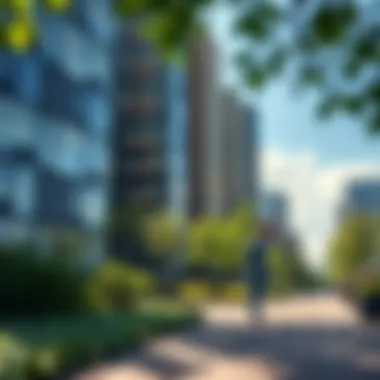
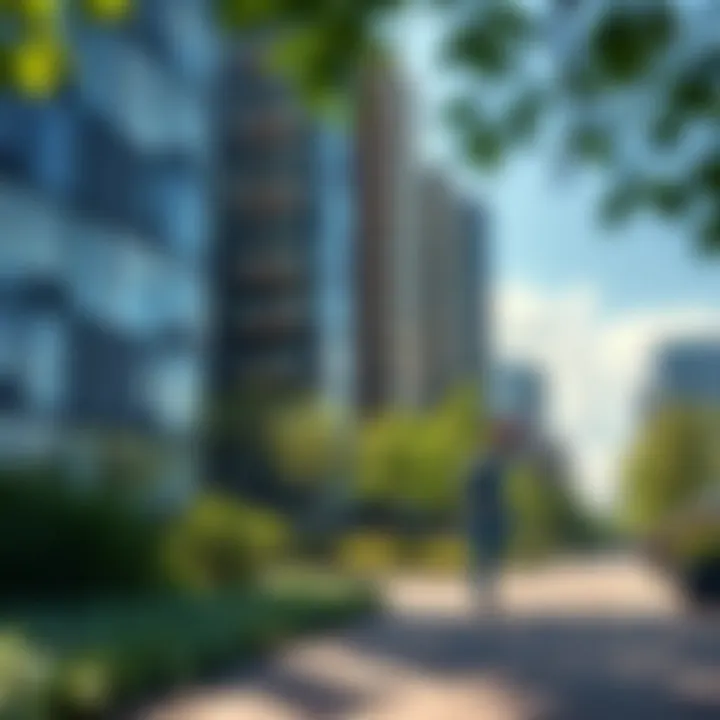
Intro
Cities are often viewed as concrete jungles, but beneath the stacked bricks and bustling roads lies a rhythm powered by nature. This relationship, often overlooked, is vital for urban living. City spaces should integrate natural elements, allowing individuals to connect with their environment. As we embark on urban strolls, we must embrace the significance of green spaces in enriching our city life.
Urban strolls are more than just a leisurely walk; they represent a commitment to communal well-being and sustainability. Given the fast-paced nature of contemporary urban existence, these walks act as a small yet impactful retreat from the daily grind, promoting mental and physical health. As the world acknowledges the necessity of green infrastructure, various cities are launching initiatives that highlight our dependency on nature, even in densely populated areas.
This article seeks to unfold the layers of ecological awareness tied to urban strolls, encouraging everyone to appreciate — and actively engage — with green spaces.
Through insightful analysis, this narrative will explore how city walks not only contribute to individual health but also bolster community ties and sustainability efforts. From examining different cities that are pioneers in integrating nature into urban living to practical tips on enjoying urban nature effectively, we aim for a comprehensive understanding of how these walks resonate profoundly within our shared environments.
Preamble to Urban Green Spaces
Urban green spaces play a pivotal role in the ever-evolving landscape of our cities. They serve as essential oases amid the concrete jungle, offering numerous advantages that can enhance the quality of life for residents. The importance of these green areas cannot be overstated, as they contribute not only to the aesthetic appeal of urban environments but also to the social, economic, and environmental well-being of communities.
One might wander through their local parks or cycle along tree-lined paths and think little of the intricate web of benefits these spaces provide. Firstly, urban green spaces, such as parks, community gardens, and green rooftops, can significantly improve air quality by absorbing pollutants. They act as natural filters, helping to reduce the levels of harmful substances in the air we breathe. This leads to a healthier population, which is a vital element for urban planners considering public health outcomes.
Social interactions also thrive in these green spaces. They encourage community gatherings and foster connections among residents. People of various backgrounds come together in parks to engage in sports, attend events, or simply enjoy a leisurely stroll. These interactions create a sense of belonging, enhancing the social fabric of neighborhoods.
Moreover, urban green areas promote physical health. By providing accessible locations for exercise and recreation, they offer spaces for walking, jogging, or engaging in other outdoor activities. Consequently, they serve as a platform for healthier lifestyles, reducing the prevalence of obesity and related health conditions.
The stewardship of public green spaces might require collaboration between citizens, government agencies, and local organizations. Engaging communities in their development and maintenance ensures these areas reflect the needs and desires of the people who use them. By fostering civic responsibility and ownership, urban green spaces remain vibrant and well-maintained—benefitting everyone.
To dive deeper into the understanding of urban green spaces, we can distinguish their components and examine their historical context. Understanding each aspect forms a comprehensive perspective necessary for appreciating their value in urban planning and development.
Defining Urban Green Spaces
Urban green spaces refer to any open area within a city that is either partially or entirely covered by vegetation. This includes parks, gardens, greenways, and even green roofs. These spaces can range from large, publicly managed city parks like Central Park in New York City to tiny community gardens nestled between apartment buildings. They all share a common thread: they contribute positively to the urban environment by providing ecosystems that can flourish amidst human development.
Some of the key characteristics of these areas are:
- Biodiversity: Urban green spaces support various flora and fauna, thus contributing to the local ecosystem.
- Accessibility: Generally designed to be within walking distance from residences, these spaces are vital for citizen engagement.
- Multi-Functionality: Many parks serve multiple purposes, such as leisure, gathering spaces, and recreational activities.
History of Green Spaces in Urban Development
The concept of integrating nature within urban areas isn’t a new trend; it has historical roots going back centuries. In the early days of city development, green spaces were often utilized for agricultural purposes or public markets. However, as cities began expanding during the industrial revolution, the focus on development often neglected nature, leading to overcrowded, polluted environments with little room for greenery.
In the late 19th and early 20th centuries, a shift occurred, prompted by a growing awareness of the negative impacts of city living on health and well-being. Influential figures such as Frederick Law Olmsted championed the importance of parks, advocating for designs that merged natural beauty with urban planning. His work on projects like New York’s Central Park marked a turning point, setting a precedent for public green spaces in urban areas.
Fast forward to today, urban green spaces have evolved significantly. They are increasingly recognized as vital components in sustainable urban planning, contributing to mental health, community cohesion, and overall quality of life. As metropolitan areas continue to grow, society must prioritize the integration of green space to foster healthier, happier, and more resilient cities.
By understanding these elements—defining what urban green spaces are and exploring their historical context—we can begin to appreciate their role and significance in modern urban life.
The Role of City Walks
City walks serve as a vital connector between the bustling urban lifestyle and the tranquility offered by nature. In a world where concrete landscapes dominate, these strolls provide an escape, allowing individuals to step out from the frenzy of city life and immerse themselves in greenery for a breath of fresh air. They are not just leisurely jaunts, but rather a meaningful engagement with one’s surroundings, offering numerous benefits that ripple through our lives.
Benefits to Personal Well-Being
Taking a walk in a green space can significantly impact personal well-being. During those few moments on a nature-filled path, an individual often experiences a rush of calmness. Scientific studies affirm that exposure to nature can reduce stress levels, boost mood, and improve overall mental health.
- Physical Activity: Walking is a natural way to increase physical activity levels, which leads to better cardiovascular health. There's nothing quite like the feeling of the sun on your face and the wind playing with your hair as you walk amidst trees or shrubs.
- Creativity Boost: It seems paradoxical, but making space in our minds through simple city walks can do wonders for creativity. Many artists and thinkers have found their best ideas sprouting forth during a casual stroll, away from desk confining their thoughts.
- Mindfulness and Reflection: These walks allow individuals to reconnect with themselves. Slowing down lets one reflect on daily happenings, encouraging mindfulness, which research indicates can help improve mental sharpness and emotional stability.
Fostering Community Connections
City walks also nurture connections among community members, creating a sense of belonging. A casual walk can lead to unexpected encounters with neighbors or even strangers. When communities invest in green spaces, they inherently foster interactions between people. A park filled with walkers, joggers, and picnickers fosters camaraderie.
- Shared Experiences: Participants engaged in community events, such as charity walks or guided tours of urban greenery, can build bonds and create shared stories.
- Cultural Exchange: In diverse cities, these paths can lead to serendipitous meetings with individuals from different backgrounds. These moments spark conversations that broaden perspectives and instill a greater sense of community.
- Local Initiatives: Cities that host regular walking events encourage laughter, chatter, and friendships, making the area feel friendly and welcoming.
Encouraging Sustainable Practices
Exploring urban areas on foot not only benefits individuals and communities but also promotes sustainability. In a time when climate change is an urgent global concern, every little action counts. While it may seem like a minor action in the grand scheme, city walks help cultivate a culture of sustainability.
- Environmental Awareness: Engaging with local parks encourages a greater appreciation for ecosystems in the city. When people walk in green spaces, they often recognize the importance of preserving them.
- Reduced Carbon Footprint: Opting for walking or biking instead of driving reduces greenhouse gas emissions. Each step helps lighten the load on our environment.
- Supporting Local Economies: As these green pathways attract walkers, they also help geenerating monetary support for local businesses. Cafes and shops thriving near such paths contribute to sustaining the local economy.
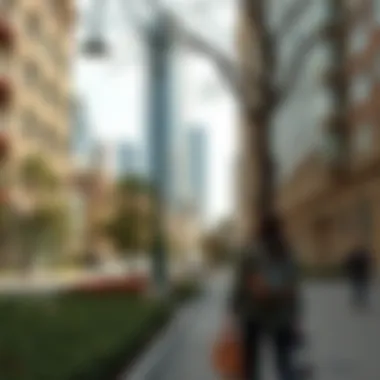

"Walking is a man's best medicine." – Hippocrates
Of course, not every stretch of greenery is a walk in the park—it takes thoughtful planning and community involvement to realize these benefits fully. As individuals embrace the role of city walks, they not only enrich their own lives but also contribute positively to their surroundings.
Exploring the Benefits of Nature Walks
Nature walks serve as a gateway to understanding the multifaceted advantages that green spaces offer in urban settings. They are not merely leisure activities; rather, they provide a foundation for enhancing personal well-being, fostering community bonds, and contributing to the ecological fabric of cities. Engaging with nature through walking helps integrate residents with their environment, allowing them to partake in a shared experience of tranquility amidst urban hustle. Keep in mind, the essence of these strolls goes beyond physical presence; it’s about forging a deeper connection with nature and community.
Enhancing Physical Health
The benefits of taking leisurely walks in green areas are far-reaching when it comes to physical health. Walking is an excellent form of cardiovascular exercise that can significantly improve heart health, boost circulation, and enhance respiratory function. Stepping outside into a park or tree-lined avenue can elevate adrenaline levels, which in turn can lead to a decrease in body weight and a reduction in chronic ailments such as heart disease and diabetes.
Furthermore, walking outdoors provides natural light and fresh air, which are crucial components for maintaining adequate vitamin D levels and improving overall immune function. The simple act of walking, especially on varied terrain, can strengthen muscles, improve balance, and enhance joint mobility. Unlike working out in an enclosed gym, urban nature walks encourage a sense of freedom, making exercise feel less like a chore and more like a delightful experience.
- Important points to consider:
- Aim for at least 30 minutes a day of moderate walking.
- Choose paths with some elevation to increase intensity.
- Wear comfortable shoes to prevent strain and injury.
Mental Health and Stress Reduction
Spending time in nature has been shown to have profound effects on mental well-being. It serves as a natural antidote to stress, anxiety, and depression—conditions frequently plaguing urban dwellers. A stroll through a city park or botanical garden can provide a much-needed escape from the chaos of urban life. The sensory input from greenery, chirping birds, and a gentle breeze can help ease the mind and bring a sense of calm.
Research has highlighted that exposure to natural environments is linked to lower levels of cortisol, the stress hormone, and improved mood states. People report feelings of increased happiness and a sense of connectedness to their environment after spending time outdoors. Incorporating nature walks into daily routines can thus be a preventative measure against mental fatigue, promoting clarity and rejuvenation in both thought and spirit.
"Nature’s peace flows into me as sunshine flows into trees." – John Muir
Contributing to Local Biodiversity
Another remarkable aspect of urban nature walks is their potential to support and enhance local biodiversity. Each step taken among plants and trees, murmuring streams and fluttering insects contributes to a collective effort to protect and revitalize urban wildlife. Even the smallest urban parks harbor a variety of species, from birds and butterflies to native plants and insects.
City walks encourage appreciation for the flora and fauna that occupy urban spaces, helping to foster a culture of conservation among city dwellers. By exploring local trails, one may encounter community-led projects aiming to restore habitats, plant native species, and educate the public on the importance of maintaining biodiversity. Moreover, every person who enjoys these natural oases becomes an advocate for their preservation, thereby creating a ripple effect for conservation efforts within the community.
- Elements to ponder on:
- Participate in local biodiversity projects to directly impact urban environments.
- Educate yourself and others about native species and their significance.
- Support organizations that focus on urban greening and environmental education.
Civic Engagement and Urban Greenery
Civic engagement in urban greenery is essential in fostering sustainable cities that cater to both environmental and community needs. As cities expand and the population grows, the pressing need for green spaces becomes more pronounced. Engaging citizens in the planning and maintenance of these spaces not only enhances their quality but also builds a sense of ownership. When people feel connected to their surroundings, they are more likely to advocate for green initiatives that enrich urban life.
The benefits of civic involvement in urban greenery are multifaceted. First, it nurtures a sense of community and belonging, as neighborhood parks or gardens become venues for social interaction. When locals gather for a common cause, like planting trees or organizing cleanups, they build relationships that transcend mere acquaintance. It transforms the urban landscape into a living tapestry woven from the diverse threads of its community members.
Moreover, involving citizens in the planning process allows for a more tailored approach to what that community needs. Each neighborhood has its unique character, and local input helps ensure that green spaces reflect that essence. Perhaps a community prefers a quiet space for meditation, while another might favor an active playground. Understanding these nuances requires genuine dialogue between planners and residents.
"Engaging the community means listening to the heartbeat of the urban landscape, and that heartbeat is diverse and vibrant."
Involving Communities in Planning
Involving communities in the planning of green spaces is not just a courtesy; it's a necessity. Planners and developers should tap into the wealth of knowledge that residents possess about their own neighborhoods. This can take the form of public meetings, surveys, or workshops, where locals can voice their ideas and concerns. These platforms provide invaluable insights, enabling planners to tailor designs that truly meet the needs and desires of the people.
For instance, in a mid-sized city, a community meeting might reveal that residents prioritize family-friendly parks over elaborate botanical gardens. Consequently, planners can shift their focus, allocating resources effectively and efficiently. This can save time and money while also ensuring community satisfaction.
Volunteer Opportunities in Local Parks
Volunteer opportunities in local parks create a participatory culture around urban greenery. When residents dedicate their time and talents to beautify these spaces, it fosters stewardship and responsibility. Local governments can facilitate this by promoting programs that encourage volunteers, highlighting upcoming clean-up drives or planting events on social media or community boards.
Not only do these initiatives benefit the parks themselves, but they also provide social value. Volunteers meet neighbors, build friendships, and develop skills. For example, a gardening workshop could teach residents about sustainable practices and the importance of local flora. These experiences can further inspire environmentally conscious behaviors, extending beyond the park’s boundaries.
Educational Programs and Workshops
Educational programs and workshops serve as key factors for enhancing civic engagement in urban greenery. They can range from nature walks that reveal the importance of local ecosystems to hands-on workshops that teach skills like urban gardening or ecological landscaping. These programs transform public spaces into dynamic classrooms, where knowledge flows freely and the importance of green spaces is instilled in all ages.
By partnering with schools, non-profits, and local experts, cities can develop curricula that resonate with their communities. Not only do these programs cultivate a more educated public, but they also yield informed advocates for sustainable initiatives. Such advocates are more likely to champion green policies, volunteer for maintenance, and inspire others to appreciate the beauty and benefits of urban greenery.
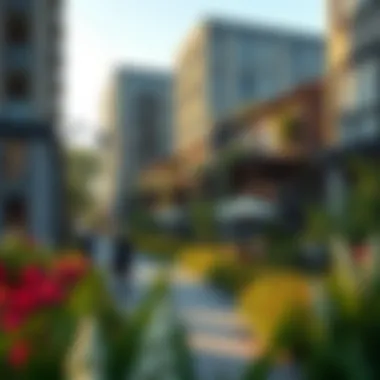
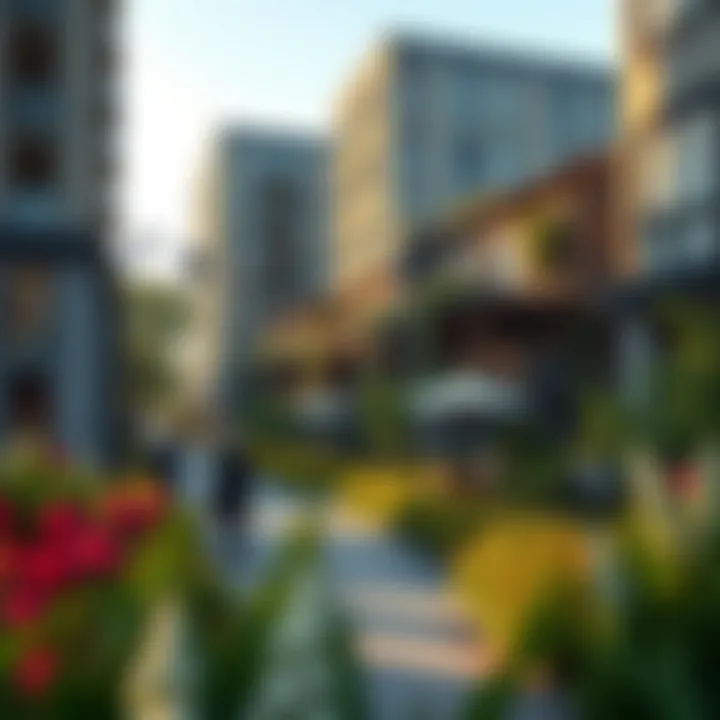
Ultimately, civic engagement and urban greenery coalesce into a powerful alliance. The more actively communities participate in the stewardship of their green spaces, the richer urban life becomes. By harnessing community insight, volunteer spirit, and education, cities can create thriving environments that respect both nature and the residents who cherish it. Advocacy for green spaces becomes not only a matter of aesthetics but a cornerstone in the foundation of urban resilience.
Case Studies of Successful City Walks
Examining successful case studies of city walks highlights how tailored urban planning can create efficient, engaging, and green environments. By studying these examples, we discover that walks not only benefit physical and mental well-being but also enhance community cohesion and resonate with environmental sustainability efforts. These case studies reflect a broader movement towards integrating green spaces more effectively in urban landscapes.
City X: Innovative Green Pathways
City X is a prime example of integrating green pathways that truly breathe life into urban settings. Here, planners took a blank canvas—a neglected stretch of urban ground—and transformed it into a vibrant corridor filled with local flora. Alongside smooth walking paths, this project included bike lanes, benches, and information kiosks that educate citizens about the benefits of nature.
What sets City X apart is its bilingual signage that invites diverse communities to explore these green routes. The pathway runs through once-abandoned railway tracks, showcasing artistic murals that tell local stories, combining culture with nature. Not only does this keep the area's history alive, but it also encourages economic revitalization as local businesses see increased foot traffic. Residents report higher satisfaction with their neighborhoods, nurturing a stronger sense of pride and belonging.
Moreover, these green pathways have led to a noticeable increase in biodiversity as various plant species were reintroduced, benefiting local wildlife while promoting an ecology-friendly urban ethos.
City Y: Revitalizing Urban Areas Through Nature
Turning now to City Y, one finds an inspiring journey of revitalization through green spaces. Faced with urban sprawl and a decline in public areas, the city initiated a major rehaul of its central park system. City Y's approach cleverly combined restoration of existing parks and creation of new urban gardens to engage and serve its community better.
The unique aspect of this city's strategy is community involvement, embodying a grassroots movement that aligns local needs with urban development. Volunteers from diverse backgrounds were included in the design process, ensuring a blend of opinions was respected. One notable feature is the community garden, where residents grow their own produce, fostering healthy eating habits and neighborly interactions.
City Y also initiated programs that encourage urban foraging, teaching residents how to gather edible plants found in public spaces, thus raising awareness of native species. Feedback mechanisms were established, allowing for on-the-go adaptations to better fit developing community dynamics. The city now celebrates annual festivals in its parks, drawing crowds and boosting local ventures, thereby knitting the social fabric tighter and ensuring sustained community engagement.
These case studies illustrate that intentional design and community involvement are paramount in creating successful urban walks. Whether through innovative green pathways in City X or through revitalizing strategies in City Y, we see the profound impact urban green spaces can have on city life.
An effective urban space can be a source of pride, health, and sustainability, reflecting the community's needs while promoting interaction with nature.
Designing Sustainable Urban Walks
The essence of designing sustainable urban walks is to create an environment where cities are intertwined with nature rather than existing in conflict with it. Such walks can enhance the quality of life for residents and visitors alike, as they promote healthier lifestyles, foster community bonds, and contribute to ecological balance. Sustainable urban walks can be the backbone of urban planning that prioritizes green infrastructure as a fundamental aspect of city life.
Integrating Nature into Urban Framework
To successfully blend urban spaces with nature, city planners must adopt a holistic approach that marries architectural design with ecological considerations. This integration can manifest in numerous ways. For example, park systems can be linked to streets through green corridors, creating pathways where pedestrians can enjoy both leisure and nature. These corridors can act as wildlife passages, encouraging local flora and fauna to flourish, which in turn enriches the urban experience.
Consideration for water management is another important factor. Implementing bioswales, green roofs, and permeable pavements can help manage rainwater runoff, allowing urban areas to absorb water more efficiently. This not only reduces flooding risks but also enhances the aesthetic appeal of neighborhoods. Integrating trees and vegetation into urban frameworks helps reduce heat islands, providing cooler, natural spaces that invite walks and outdoor gatherings.
"Green infrastructure is not just a visual enhancement; it’s a vital component of urban resilience".
By treating nature as an essential fabric of the city, urban planners create vibrant spaces that encourage walking. Well-lit trails lined with trees and native plants make the walks appealing, while plazas furnished with benches and shade improve usability.
Utilizing Native Plants in City Landscapes
When considering urban landscape design, opting for native plants can have profound implications for sustainability. Native plants are adapted to the local climate and soil conditions, meaning they require less water, fertilizer, and pesticides compared to non-native species. This fosters a more resilient ecosystem and lessens the demand for resources.
Incorporating these plants into urban settings provides additional benefits:
- Biodiversity: Native plants attract local insects, birds, and animals, creating a balanced ecosystem.
- Cultural Connection: Using plants indigenous to the area can be a nod to the historical landscape and cultural heritage of a region.
- Aesthetic Value: These plants often showcase beautiful blooms and unique textures, providing visual interest year-round.
Urban gardens, parks, and streetscapes designed with native species promote community pride and education. They invite residents to participate in stewardship, understanding the importance of preserving local ecosystems. Engaging citizens through workshops on native gardening can enhance awareness and draw people outside to enjoy their city in a new way.
In sum, designing sustainable urban walks is about merging the built environment with the natural one to create spaces that emphasize health, connectivity, and ecological sustainability. City planners and communities must work together to prioritize green infrastructure, ensuring that urban life and nature can not only coexist but thrive in harmony.
Practical Tips for Enjoying City Walks
City walks can be a delightful way to immerse oneself in the natural beauty tucked within urban landscapes. A bit of preparation can amplify this experience, ensuring that it is both enjoyable and enriching. Understanding how to navigate city paths effectively can lead to discovering hidden gems and fostering a deeper connection to the environment. Whether it’s exploring a bustling neighborhood park or a serene rooftop garden, practical tips help enhance the journey.
Choosing the Right Route
Selecting a route for your urban stroll makes all the difference. Taking the time to consider the path can lead to unexpected delights. Here are a few factors to keep in mind:
- Local Recommendations: Often, residents have insights that are not captured in guides. Chatting with locals or reading community boards can reveal lesser-known paths and parks.
- Diverse Environments: Look for routes that blend different green spaces. This mix keeps things interesting and allows you to enjoy various types of flora and fauna. For instance, starting in a park with grand oak trees and moving to a garden filled with blooming flowers can be exhilarating.
- Accessibility: Ensure that the route is easy to traverse. If the goal is relaxation, avoid steep inclines or busy roads. Instead, opt for wider sidewalks and areas away from high traffic zones.
- Time of Day: Different times of the day provide unique experiences. Early mornings might offer tranquility with a refreshing atmosphere, while late afternoons showcase the vibrant life of the city.
Experimenting with routes can lead to unique discoveries and deeper locales that a standard path may have missed. All in all, think of each stroll as an adventure waiting to unfold.
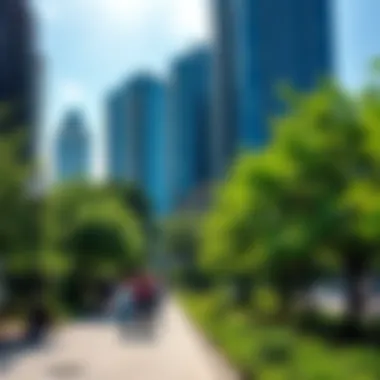

Packing Essentials for Urban Strolls
Being prepared equipment-wise can make or break a city walk. Here’s a handy checklist to ensure you hit the pavement with everything you need:
- Comfortable Footwear: This one’s a no-brainer. Supportive shoes prevent fatigue and keep blisters at bay.
- Water Bottle: Staying hydrated is crucial, especially for longer walks. Look for reusable bottles to help cut down on waste.
- Weather Gear: A light jacket or umbrella for unexpected rain can save the day. Conversely, if it’s sunny, pack shades and sunscreen.
- Snacks: Healthy nibbles like nuts or fruit provide quick energy but keep light enough not to weigh you down.
- Navigation Tools: Whether it’s a digital map or an old-fashioned compass, having a way to find your bearings is essential. An app that can showcase green routes can also be an asset.
- Portable Charger: For longer walks, ensure your phone is charged. It’s handy for navigation or to snap photos of your adventures.
Packing smart not only prepares you physically but also enhances your overall experience, letting you focus on the beauty around you rather than logistics.
"The best city walks are those where you lose yourself in the moment, not in the map."
With these tips in mind, your urban explorations will not only be enjoyable but will also open the doors to a better understanding of your environment. Each stroll can lead to new insights and connections, forming a tapestry of experience that enriches urban life.
Challenges in Urban Green Space Development
Urban green spaces are essential for enhancing the quality of life in cities, but their development often faces significant obstacles. Understanding these challenges is crucial because they not only affect the availability and accessibility of these spaces but also influence ecological sustainability and community health. As urban populations continue to swell, the demand for greenery in metropolitan areas becomes even more pressing, making it vital to address issues that impede their growth and maintenance.
Space Constraints in Metropolitan Areas
In bustling cities, real estate comes at a premium. Land is mainly allocated for residential and commercial use, making it difficult to carve out areas for green spaces. The relentless march of urbanization can squeeze these spaces into smaller margins, often relegating them to rooftops or alleys—places that may lack visibility and easy access. Cities like New York have found creative ways to utilize underused land, such as repurposing parking lots or designing pocket parks on vacant lots.
However, these solutions are often temporary and insufficient to meet the growing need for recreational spaces. An example can be found in San Francisco, where limited plot sizes complicate efforts to expand city parks. As real estate developments expedite, the consequences are clear: parks have become fragmented. This breaks the continuity that is so vital for biodiversity and resident well-being.
With innovative planning and community design, some regions are establishing urban forests and green corridors that connect different parks. These communal efforts often involve local citizens who are passionate about preserving nature in their cities. Yet, even with these advancements, they can only do so much against the backdrop of persistent space constraints.
Funding and Resource Allocation
In many instances, limited funding hinders urban green space project proposals. Budget allocations frequently prioritize immediate infrastructure over long-term ecological benefits. According to studies, every dollar spent on parks can yield a return of multiple dollars in health and economic benefits. Yet, municipalities often find themselves stretched thin, battling for budgetary resources amidst competing needs such as housing, education, and transportation infrastructure.
Cities can explore various avenues for funding by looking beyond traditional tax revenues. Grant programs, public-private partnerships, and community fundraising are just a few options. For instance, Chicago has successfully leveraged corporate sponsorships to fund elements of its city’s green spaces. Local businesses have teamed up with park districts to enhance facilities and create educational programs.
However, the challenge remains that these funding sources can be unevenly distributed, often favoring affluent neighborhoods while underserved communities continue to face neglect in their access to green spaces. As urban planners work to bridge these gaps, it becomes clear that equitable distribution of resources is paramount. This benefits not only marginalized communities but boosts the overall urban ecology by ensuring diverse ecosystems flourish throughout the city.
"Investing in urban green spaces isn’t just an aesthetic consideration; it’s a necessity for a healthier society."
The Future of Urban Green Walks
As cities expand and adapt to the challenges posed by climate change, urban green walks hold a significant promise for creating more vibrant, sustainable, and inclusive environments. The integration of green spaces into urban planning is not merely a trend but a vital necessity for communities striving for resilience and well-being. Understanding the future of urban green walks entails examining their potential benefits, the pressing need for adaptation to climate change, and the role of technological innovation in urban development. Together, these elements can shape a more harmonious existence between nature and urban living.
Adapting to Climate Change
Adapting urban green walks to climate change is essential, as urban areas are particularly vulnerable to the impacts of severe weather, rising temperatures, and increased flooding. Green spaces help mitigate these issues by enhancing stormwater management, reducing heat islands, and improving air quality. For example, cities like Singapore have pioneered strategies that incorporate greenery into their architecture. Vertical gardens and rooftop parks are not just pretty pictures; they are integral strategies that help combat the urban heat island effect, balancing temperatures across neighborhoods.
- Urban Heat Mitigation: Green walks can provide shaded areas, cooling the environment and making outdoor spaces more enjoyable.
- Water Management: Planting strategically placed greenery helps absorb excess rain, reducing runoff and the risk of flooding.
- Biodiversity Enhancement: Increased green spaces support diverse species, aiding in ecological balance and resilience in urban ecosystems.
As communities increasingly recognize the benefits, city planners must prioritize the expansion and maintenance of these green corridors. Collaborations between local governments and environmental organizations can facilitate these adaptations, ensuring urban green walks evolve to meet the challenges posed by a changing climate.
Technological Innovations in Urban Planning
Technological advancements are revolutionizing how we design and implement urban green walks. Today, planners are harnessing data analytics, GIS (Geographic Information Systems), and artificial intelligence to optimize green space development. Such tools allow for dynamic planning that can adjust to real-time environmental conditions.
- Smart Sensors: Implementing smart sensors in parks can inform city officials about air quality and biodiversity levels.
- Augmented Reality (AR): Utilizing AR in urban environments can enhance the experience of walks, educating users on native plant species and sustainability practices as they stroll.
- Sustainable Materials: Innovations in materials for pathways, like permeable concrete, increase water filtration and reduce stormwater runoff, ensuring that the integration of green walks does not compromise urban infrastructure.
Ultimately, the intersection of technology and urban green walking spaces not only improves accessibility but also empowers citizens to take an active role in their environment. By engaging local residents through platforms that invite feedback and suggestions, urban planners can create spaces that truly reflect the needs and desires of the community.
"The future of our cities depends on integrating nature into urban life. Green walks are a building block for resilience in the face of climate change."
As we peer into the horizon of urban landscapes, it is evident that these green walks are more than just pathways; they are lifelines fostering community interaction, ecological stewardship, and a healthier way of life.
Finale
Reflecting on the intricate tapestry of urban life entwined with nature, the importance of understanding and cultivating urban green spaces cannot be overstated. The journey through the heart of our cities reveals not just a patch of grass or a row of trees, but rather an ecosystem that supports physical health, emotional well-being, and community unity.
Reflecting on Urban Life and Nature
As city dwellers, we often find ourselves living in concrete jungles, where the hustle and bustle drown out the natural rhythm of life. Yet, this relationship between urban living and nature speaks volumes about how we navigate our spaces. Studies show that access to greenery in cities positively impacts mental health, reducing stress and fostering a sense of serenity. It’s not merely an aesthetic supplement; it’s a vital resource that enriches lives.
- Health Benefits: Research indicates that spending time in nature improves cardiovascular health. Regular strolls through green parks bolster physical fitness and enhance mood.
- Community Spirit: Green spaces foster connections. Neighbors can engage in conversations while enjoying a common space, leading to a stronger sense of community.
- Environmental Responsibility: Urban green walks remind us of our role in preservation. When individuals experience nature’s beauty, they often develop a protective instinct toward it. This awareness drives advocacy for more sustainable practices.
The future is bright for urban green walks. As cities continue to expand, integrating nature into urban planning becomes crucial. More parks, community gardens, and green walkways are not just luxuries, but necessities for a healthier populace. Civic engagement in these projects ensures that local needs are met, creating spaces that resonate with those who live nearby.



